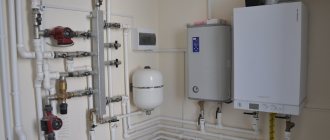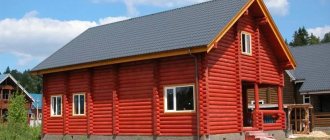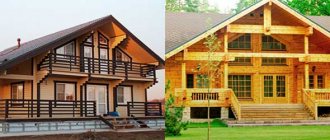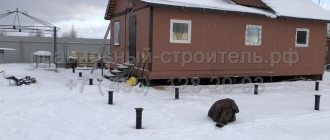Types of heating systems
To organize space heating, you can use several heat sources at once. Heating installation in a wooden house can be done using the following heat generators:
- bake;
- fireplace (classic or modernized);
- gas convector;
- electric convector;
- heat gun.
When choosing a suitable option, it is worth considering how light and easy it will be to operate. The cost of equipment maintenance becomes an important factor; sometimes incorrect calculations lead to unnecessary costs. The same applies to reducing heat losses to a minimum. An important role when creating heating in a wooden house with your own hands is played by the aesthetic appearance of the units and their compliance with the chosen interior.
Aluminum heating radiators
Aluminum radiators appeared on the market relatively recently and have become popular due to their appearance. However, in addition to their beautiful appearance, they have a lot of limitations, mainly related to their characteristics. Don't install them without thinking.
Aluminum radiators have high power and quickly heat up the room, spending much less coolant than, for example, cast iron ones. Like steel, aluminum radiators fit perfectly into any interior.
Due to its chemical properties, aluminum is resistant to alkaline environments. Therefore, when installing aluminum radiators in your home, be prepared for the fact that you will have to constantly monitor the quality and pH of the coolant. The pH should be from 7 to 8, and even drinking water does not always have such indicators.
There are other nuances when installing aluminum radiators, so it is better to entrust their installation to professionals.
Distinctive features of pumping systems
The movement of the coolant at a suitable speed is ensured by a special pump. This helps to avoid temperature loss and also leads to faster heating of the premises.
A common system is a system with natural water circulation. Due to the difference in pressure, the liquid returns to the boiler after cooling. The warming up process is carried out more slowly, but the cost of installing a system of this type is more affordable for a wide range of buyers.
High efficiency can be achieved by installing a circulation pump. The use of such a system makes it possible to use pipes of smaller diameter. With natural circulation, the volume of heated space is limited; when operating a circulation pump, there are no space restrictions. Additional equipment requires money to be spent at the purchase stage, but the efficiency of its use will reduce fuel consumption, so it will bring tangible benefits.
Using long-burning TT boilers
Not every homeowner has the technical ability to connect powerful electrical equipment, which includes combined and purely electric boilers. The reason is the limitation of the allocated power limit for a private house. The size of the limit depends on the capacity of local power supply networks, which the owner of a country cottage cannot increase.
In the absence of natural gas on the site or with the high cost of connecting to the main line, there is only one real solution - buy a long-burning wood and coal boiler or make it yourself. The operating time from 1 load for a conventional TT boiler is 3-6 hours, which forces the owner to work near it as a stoker. A comfortable interval between fuel additions is at least 8 hours, and not every heater provides that much.
The latest pyrolysis boiler with an increased firebox volume ATMOS D30
The trouble is that any seedy manufacturer calls their products long-burning boilers in order to sell them to an ignorant user. You can recognize the correct unit among other heat generators by the following features:
- with the same power, a boiler with a large power reserve is equipped with a firebox of increased volume (from 100 l) and differs in size;
- the passport indicates a burning duration of 8 hours (on wood);
- For convenience, the unit is equipped with an additional loading door.
Detailed information about heat generators of this type and recommendations for their selection are published in a separate topic.
Heating boiler diagram
Water heating in a wooden house cannot be imagined without a boiler that provides heating of the coolant. The boiler is a device operating in automatic mode. There are several types of equipment that use different types of fuel.
Heating boiler diagram
The heating system in a wooden house can be installed using the following types of boilers:
- gas;
- electrical;
- diesel;
- working on solid fuel.
It is worth considering separately the features and types of infrared heating. This model of heating system uses electricity to operate, and at the same time has economical consumption compared to electric boilers. The disadvantage of this option is the inability to heat large rooms; often infrared equipment plays a supporting role.
How can you heat a house outside the city?
There are a lot of options, starting with traditional wood heating and ending with solid fuel boilers that can heat large areas:
| Wood burning stoves Once upon a time, all houses in rural settlements were equipped with wood stoves. A couple of decades ago, this was the most common heating option in the middle zone; forests in the North-Western, Central and many other regions of our country were rich enough to supply everyone with wood as fuel. Today, wood has become much more valuable, and fuel for wood-burning stoves, barbecues, fireplaces and other similar devices is produced from waste from wood processing enterprises. And the high cost of such fuel prevents its widespread use. | |
| Solid fuel boiler equipment This type of heating systems includes a variety of boilers heated with coal, wood or peat briquettes and other types of fuel. Such a system requires special training for those who use it, otherwise they will have to pay a specialist who will ensure the correct and safe operation of the boiler room. Therefore, such heating systems are mainly used in apartment buildings. There are exceptions - large country cottages, the owners of which have completed training courses and received a document confirming this. | |
| Liquid fuel boilers This type of equipment operates on various liquid fuels. It is advisable to use such heating if, not far from your home, there is an enterprise that sells fuel waste, such as fuel oil. Otherwise, heating the house will be too expensive. | |
| Gas equipment Along with electric, one of the popular types of heating. Gas is an inexpensive fuel, which determines its frequent use in country houses. The disadvantages include the high cost of installation, equipment and development of technical documentation. | |
| Electricity Electric heating of a log house is a common option, along with gas. An electric boiler does not require permits or special courses; electrical networks are more accessible than gas lines. But many homeowners find this method of heating a building too expensive. Let's figure out whether this is so, and in what cases heating with electricity is more appropriate than other types of heat generation. |
Gas boilers
If it is possible to connect to a gas pipeline, a gas boiler in a wooden house will be a good option. There are three types of boilers:
- atmospheric (a distinctive feature is a constant combustion mode, but when heated to a certain level, the gas supply automatically stops);
- turbine (in many ways similar to atmospheric, the difference is the presence of an air mass control system);
- condensation (has a more complex structure, in it the condensate located on the surface of the combustion chamber is first heated, which subsequently heats the coolant).
Gas boilers
Condensing boilers from Germany are characterized by high energy efficiency; they have decent efficiency. The only reason to refuse such equipment is the need to install heating in a wooden house without gas.
Method 7 - infrared heaters (the most economical)
Infrared heaters are considered the most economical of all types of electric heaters. They do not need heating elements and water pipes. Infrared heaters heat objects, not the room. Then the heated objects heat up the air. If an electric boiler can be compared to a kettle, then an infrared boiler can be compared to a microwave oven.
Infrared panels are especially popular. They are installed on the ceiling or walls of residential and industrial premises. Since the heating area is increased, the room becomes warmer faster than usual. Such a panel can be used as an independent heating source or as an addition to an existing system. An infrared heater goes well with electrode boilers. For example, an infrared heater can only be turned on in spring and autumn, when it is too early to turn on the main heating, or when it suddenly gets cold outside.
Pictured is a GROHE infrared panel, Germany
Electric boilers
Electric heating in a wooden house involves the use of two boilers, one of which performs only an auxiliary function. The main boiler is a model in which the heating element function is performed by a heating element (tubular electric heater). In some cases, an electric boiler with electrodes is used; its operation is carried out using the ionization of water molecules.
Electric boilers
Before choosing electric heating in a wooden house, it is worth considering the subsequent costs. The equipment itself is inexpensive, but the price of electricity may scare off potential buyers. This method has advantages:
- small size of the unit;
- complete safety of use;
- possibility of autonomous operation (without human intervention);
- Efficiency is close to 100%.
How to save on electric heating
A convenient type of heating with electricity is not such a cheap pleasure, so it is necessary to take measures to reduce its cost. First, the power of electric heating is calculated. For an approximate calculation of thermal power, take 30 W per 1 m³.
Distribution of warm air in a room with convection heating and comfortable infrared heating
Power can be calculated more accurately using special programs. The next step in saving energy is to use a thermostat with a temperature sensor. Optimal thermal conditions will help save electrical energy. Installing a two-tariff meter will also reduce the cost of electricity. Good insulation of a wooden house is also important.
Wood retains heat perfectly, and if you also seal all the cracks, windows and doors, you can save electricity on electric heating twice as much. I would like to note that gas heating is by far the cheapest heating option, so if it is possible to connect to a gas pipeline, do so.
Did the article help you?
Solid fuel boilers
If the cost of electrical energy is unaffordable and there is no possibility of connecting to gas, the best choice would be a solid fuel boiler in a wooden house. There are various models of equipment with different firebox heights. One load of fuel allows the unit to operate autonomously for up to 12 hours. The most popular types of fuel are coal and wood. This type of boiler is the most profitable in terms of operating cost.
Solid fuel boilers
The disadvantage of heating in a private house using solid fuel boilers is the dependence of the efficiency on the level of humidity. You should not choose too cheap models, otherwise you will have to deal with such troubles as the formation of soot and soot. Most inexpensive boilers require frequent cleaning, which takes a lot of time.
conclusions
- It is generally accepted that heating a house with electricity is not cheap. This is certainly true if we mean only payment according to tariffs. However, to the price of heating you need to add the cost of the equipment, as well as the costs of its maintenance and repair.
- If you compare bills for electricity, firewood, coal, pipes, boilers and other equipment, you can come to the conclusion that private heating with electricity is cheaper than solid-state boilers, stoves and other systems alternative to gas heating.
- In addition to money, there is another argument in favor of electric heating - it saves time: turn it on, leave and forget. The only downside is a sudden power outage.
Below, watch a video about how we managed to create cheap heating with electricity for a large private house.
Diesel boilers
One of the common options for heating a wooden house is purchasing a diesel boiler. The advantage of such systems is their ease of installation and subsequent operation. When installing most models, you do not have to worry about the need to create a complex chimney system.
Diesel boilers
When using water heating, such equipment will have a number of disadvantages:
- high fuel consumption (15 liters per day) and corresponding maintenance costs;
- low efficiency rate (from 75 to 85%);
- the need for constant monitoring (if bad fuel is used, work may simply stop).
Among all the options, this one has the lowest efficiency and the need for constant monitoring, however, quick heating of the room and the ability to regulate the temperature make the installation of a heating system of this type popular. You can also choose a diesel boiler if fuel costs do not become a serious problem for you.
Criteria for choosing a heat generator
There is simply a huge selection on the market - domestic and foreign manufacturers offer a wide variety of models. From such an assortment, a buyer with any income level will be able to choose something for himself.
In order not to make a mistake when buying a boiler, you need to check what type of fuel is most available in the region. It is also important to correctly calculate the power of the equipment.
Advantages of gas units
The vast majority of owners of wooden houses opt for gas equipment.
The popularity of wall-mounted and floor-standing gas boilers is due to the fact that such fuel is one of the cheapest in many countries. In addition, with its help you can organize a completely autonomous and maintenance-free heating system.
The list of advantages of gas boilers needs to be supplemented:
- High efficiency . Even a low-power device generates more heat than its counterparts running on other types of fuel.
- Ease of operation . No need to worry about where the fuel will be stored. At the same time, using such equipment is easy - you only need to set it up once.
- Durability . A high-quality gas unit will last at least 15 years.
The main disadvantage is the need to obtain special permission to install it. All other disadvantages are completely offset by advantages.
If you need to heat a large house with an area of more than 100 m2, then it is better to refuse a gas boiler. In this case, it will be an economically unprofitable solution
Diesel component in the system
Diesel-powered equipment has become increasingly popular over the past few years. First of all, liquid fuel boilers are cheap to maintain and easy to install.
At the same time, there is no need to organize a complex chimney design - many models run on light heating oil. The only thing required is to organize the pipe outlet in the form of a sandwich. It has a special turbine that pushes out air.
If you have decided to install a diesel boiler, you need to understand that this heating method will be expensive. After all, the efficiency of this equipment varies from 75 to 85%, which is a rather low figure.
Also, a diesel-powered unit requires constant monitoring. If it is left for at least a week, it will lead to problems. Indeed, due to the low quality of fuel, the equipment may stop. As a result, the water in the pipes will freeze and burst.
Even despite all the advantages of a diesel device, it should only be installed if this is the only available way to organize a heating system
Solid fuel boiler
This type of equipment is as popular as gas equipment. Great demand is due to the efficiency and environmental friendliness of solid fuel boilers. After all, such a device is the cheapest device to operate. At the same time, it burns renewable fuel and is highly energy efficient.
The market offers an impressive selection of solid fuel boilers. Savings in this matter are not always justified - if you decide to buy the cheapest model, you need to be prepared for the appearance of soot, soot and come to terms with the need for frequent cleaning.
The only disadvantage of solid fuel boilers is the need to allocate space for storing fuel, which requires quite a lot for its operation
Electric heat generator
Equipment that uses current in its operation is the only solution for those regions where centralized communication systems are not installed. Most often it is used as an additional option.
Today, manufacturers offer a wide range of electric boilers. Models with power from 6 to 30 kW are available on the market. Such a wide range of performance allows you to order the device for a wooden house of any size.
Advantages of the equipment:
- small dimensions;
- operational safety;
- complete autonomy;
- cheapness;
- Efficiency approaching 100%.
But keep in mind that electricity is the most expensive energy carrier. Therefore, even despite the low cost of the unit, operating such a system will be expensive.
Electric boilers are completely safe for a wooden house. But to avoid problems, you need to install a meter and select a cable with a calculation of 8 amperes per 1 mm2 of its cross-section
Power calculation rules
To determine the optimal performance of the boiler, it is not at all necessary to seek help from a specialist. To do this, you only need to determine the amount of heat loss. Knowing this value, it must be multiplied by the area of the house and the resulting number will be the required power.
If the building is not insulated in any way, then heating one square meter will require from 130 to 200 W. For buildings with old windows and a facade that is covered with material that does not allow cold to pass through, the optimal value will be 90-120 W/m2.
As for houses with good thermal insulation of attic and basement floors, plastic double-glazed windows, insulated doorways, properly arranged air exchange, then 50-80 W/m2 will be enough to heat them.
Warm floor
Modern homes often use underfloor heating to create a more comfortable environment. If the power is correctly calculated, such a system can be used as a method of heating rooms if there is no severe frost outside. When using a water system, pipes are laid under the final coating, thereby heating the surface.
Warm floor
If you use an electric heating connection in a wooden building, you should definitely install heated floors. This will increase consumption slightly, but the increase in comfort will be clearly felt.
Underfloor heating is rarely used separately as heating; most often it is part of a combined system. When installing, take into account the need for additional thermal insulation to comply with fire safety regulations. Before installation, it is worth taking care of the possibility of temperature control in order to control the condition of the system.
Direct electric heating
Oil radiators
The housings of these devices consist of several sections with mineral oil as a coolant, which is heated by powerful heating elements up to 200 degrees, maintaining the radiator temperature no higher than 100 degrees.
Oil radiators are capable of heating any living space; they do not “burn” oxygen during operation, but they are used only in extreme cases due to the high consumption of electrical power.
Convectors
In these devices, a heating element heated by electric current directly heats the air without an intermediate coolant. Therefore, they have higher heat transfer and efficiency, but at the same time some of the oxygen is burned out of the air in contact with the hot metal of the heater.
With the radiator and convector method, cold air from below the room, after heating, rushes upward and collects near the ceiling, and from there it is distributed throughout the entire volume of the room.
Therefore, when the temperature at the top of the room reaches +22°C, the air near the floor will warm up to +17°C, which is quite acceptable, but not entirely comfortable.
Convectors use temperature sensors with automatic temperature control systems, which can significantly save energy costs.
Attention! The convector located below the window protects the room from the penetration of cold air through cracks from the street, preventing drafts.
Options for choosing the right system
It is impossible to talk about a clear advantage of one system over all others; in a particular case, your own option is optimal. The following factors should be taken into account:
- cost of equipment;
- cost of radiators and other consumables;
- operating and maintenance costs;
- efficiency;
- exercising control;
- frequency of residence in the house (all year round or only in warm weather);
- types of thermal media used.
Each factor must be taken into account to make an informed decision. Do not forget about the aesthetic component of the question of how to hide and conceal heating pipes. All potential problems should be considered at the stage of choosing the type of system. Do-it-yourself heating schemes for a wooden house allow everyone to carry out installation independently without the involvement of third parties.
Using solar energy
If you live in a sunny region of Russia, then solar panels will be an excellent solution for you, which will generate heat and heat water most of the year. You won’t have to pay utility bills every month, and the heat will be taken “out of thin air.” This is suitable for owners of summer cottages that are used only periodically, for example, for planting crops in the garden and for a summer holiday in a cozy country house. Consumers who install such systems are not afraid of power outages. You can also use photovoltaic panels, which are used as an additional power source. If there are power outages, the energy from such devices will be enough to keep boilers and heaters running for several hours, as well as watch TV and charge your phone.
Contrary to all stereotypes: a girl with a rare genetic disorder conquers the fashion world. This girl's name is Melanie Gaydos, and she burst into the fashion world quickly, shocking, inspiring and destroying stupid stereotypes.
11 Weird Signs That You're Good in Bed Do you also want to believe that you please your romantic partner in bed? At least you don't want to blush and apologize.
7 Body Parts You Shouldn't Touch with Your Hands Think of your body as a temple: you can use it, but there are some sacred places that you shouldn't touch with your hands. Research showing.
9 Famous Women Who Have Fallen in Love with Women Showing interest in people other than the opposite sex is not unusual. You are unlikely to be able to surprise or shock anyone if you admit it.
10 charming celebrity children who look completely different today Time flies, and one day little celebrities become adults who are no longer recognizable. Pretty boys and girls turn into...
20 photos of cats taken at the right moment Cats are amazing creatures, and perhaps everyone knows this. They are also incredibly photogenic and always know how to be in the right place at the right time.
Types of thermal media
Thermal energy can be transferred in various ways; the following options can be considered:
- air heating of a wooden house;
- using water (the most popular option);
- stove heating in a wooden house;
- underfloor heating systems.
We have already discussed the underfloor heating system above; it will not be able to fully provide the house with heat in the winter. This option is used as part of a system with different coolants or when living in a cottage only in the summer.
Water is most often used as a coolant for many reasons. This is the easiest way to provide room heating; the system will have high performance and efficiency.
Stoves for heating a wooden house are a traditional option for heating rooms. This method has been tested by time; in our time, it remains in high demand. Stove heating in a wooden house is sometimes not capable of heating distant rooms, which becomes a serious drawback. However, when combined with other options, the stove demonstrates good efficiency indicators.
The use of air as a coolant is also often used. It is relatively safe; the downside is often significant heat loss during long-distance transmission. If you plan to heat houses with a large area, you will have to think about a way to avoid a drop in temperature when moving.
Separately, it is worth noting quartz heating, which is more economical compared to classic electric heating systems. Quartz equipment consumes several times less electricity, while being able to heat rooms in a short time.
Method 5 - induction boiler
An induction boiler is a transformer with two types of winding. The resulting eddy currents follow the short-circuited loop, which is the boiler body. The secondary winding receives energy, which is converted into heat, heating the coolant.
Induction boilers heat your home quickly, can operate at low voltage, and have no parts that can fail. The efficiency of such a boiler is almost 100% and does not depend on the service life.
The photo shows an induction boiler EPO Evan 9.5 kW, Russia
What can you save on?
When purchasing equipment and installing a heating system, the issue of saving invariably arises. Correct calculations of power will allow you to spend less money, while in terms of comfort you will not lose anything. For example, there are several options for installing a gas boiler in a wooden house. The heat exchange pattern and overall efficiency depend on its location.
The efficiency of the system depends on how good the heating radiators are, which ones are best to use in a particular situation, calculations will show. These elements may have different designs. A massive element will not be highly efficient if you need to heat a small room. Radiators according to the type of material used are divided into the following types:
- aluminum (they can be cast or obtained as a result of processing a workpiece);
- panel steel (ease of installation, efficiency of use);
- cast iron products (they take a long time to heat up, but can be used for more than half a century);
- tubular steel;
- modern bimetallic structures.
If gasification is present, you should first consider options using gas for heating. Options may vary in cost; you can always choose the best option for a particular case. It is possible to install a stove under a gas boiler, which will make your life more comfortable.
Advantages and disadvantages of electric heating of wooden houses
Electric heating comes in two types: the familiar convection heating using electric batteries or water heating connected to an electric boiler, and the relatively new infrared heating. The latter carries out the tasks assigned to it using special heater devices.
Like any other method, electric heating has its pros and cons. For a thorough analysis, it is worth considering them in detail and drawing conclusions.
Advantages:
- no need for a chimney;
- ease of equipment installation (you can install it yourself, without the help of specialists);
- automation of modern equipment (the presence of thermostats and other devices that completely avoid manual control);
- there is no need for a special room for storing fuel.
There are other positive aspects, but they relate to certain types of heating systems using electricity. For example, electric and infrared heaters do not require an extensive system of water-bearing pipes, which facilitates installation and makes the interior of the room less loaded with unnecessary elements.
Flaws:
- electric heating devices have a high fire hazard class, so many requirements are imposed on the installation location of such devices;
- unlike the gas system, electrical networks often need repairs, so in houses with year-round occupancy, it is not uncommon for the temperature to drop due to a power outage;
- in order to avoid the case described above, it is necessary to purchase a generator, which will not be cheap;
- Electricity as a source of heat costs a lot, although there are options for solving this problem - multi-tariff meters, modern types of heaters, etc.
The imaginary disadvantage of this heating method is the high cost of electricity. In fact, with thoughtful design of the heating system and the use of modern equipment and devices, the price is significantly reduced.
Heating system installation
Self-installation forces you to take into account the following operating features:
- installation of special compensators;
- selection of material for pipelines and radiators;
- correct connection of all elements so that there are no leaks;
- wiring on all floors, reducing the number of risers to a minimum.
Installation of a heating system
It is worth deciding where the boiler room will be located in a wooden house. For its arrangement, basements or a separate extension can be used. There are always different options for how to attach a boiler room to a wooden house, differing in the cost of installation, the complexity of the work and the ease of subsequent operation.
Replacing the battery
The device is equipped with a lithium battery ER14250 or CR2032. Possible replacement options are given in the user manual.
To replace you will need:
- Remove the terminal compartment cover secured with screws on the front side.
- Dismantle the electronic unit in the same way.
- Remove the used element by soldering a new one.
- Reassemble the device in reverse order.
After completing the work, the organization that changed the battery indicates this fact in the corresponding section of the meter passport.
Date: September 25, 2022
Single pipe system
The heating system can have a different number of circuits; the single-pipe version is most common. A single-pipe system ensures that hot water rises due to the difference in mass and density with the colder part of the coolant.
Single pipe system
This option is best used for small houses, since with natural circulation the difference in temperature on different floors will be felt. A good way to get rid of this drawback is to use a circulation pump. It is worth calculating all the expenses to understand whether this option will have truly suitable efficiency.
Piping diagram
There are two main two-pipe wiring schemes. In the first case, radiators are connected to pipes surrounding the perimeter of the house (scheme with a parallel movement of the coolant). The advantage of this scheme is the relatively low pipe consumption, the disadvantage is a noticeable drop in the temperature of the coolant as it moves away from the heating boiler.
To overcome this drawback, a wiring diagram is used where two pipes go to each radiator from a collector installed on each floor. It is advisable to install collectors closer to the center of the house so that the length of the pipes to the radiators is approximately the same. Sometimes, in order to save money, a combined scheme is used, when the perimeter of the house is surrounded by large-diameter pipes, and radial wiring is arranged from them to the radiators in each room.
For hidden pipe distribution under the floor and inside the ceilings, as a rule, pipes made of cross-linked polyethylene or metal-plastic, which are supplied in rolls, are used. For external wiring, rigid polypropylene pipes are most often used, the connections of which are welded.
Two-pipe system
If there are two circuits, the hot coolant enters the radiators through a separate line. This ensures faster heating of the rooms, as well as the same temperature in opposite parts of the building. In large houses, uniform heating is important, so this option is optimal there.
Two-pipe system
Sometimes there is a need to expand the house and make new extensions. When using a double-circuit heating system, this will not be a problem; such a system is considered scalable, that is, you can always extend any line. When building houses with a large area of premises, opt for a two-pipe system.











